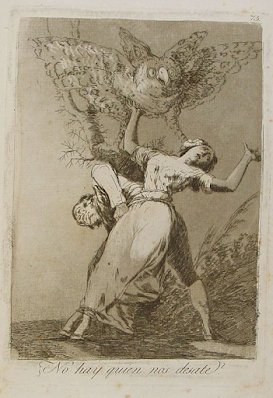Francisco José de Goya y Lucientes (1746 - 1828) paintings, drawings and engravings reflected contemporary historical upheavals. He supported the new enlightened and educated spirit of the times by opposing arranged marriages. At that time, the function of marriage was merely a means to promote the economic or social success of the family and ignored the pain that people suffered.
** Report by Karla Ingleton Darocas. Hons. B. A. (KarlaDarocas.com)
In the Capricho No. 75: ¿No hay quién nos desate? Is there no one to untie us? - we see that a man and a woman are tied at the waist to the boot of a dry tree in the middle of a field full of bushes. They are both struggling to let go; the man is convulsively trying to lean his upper body forward and she, with her legs tied at the ankles, is moving to the other side with her arms raised. Above them flies a huge owl with a curved beak and jagged eyes, resting one of its talons on the woman's face with a pained expression.
The manuscript of the Museum Nacional del Prado explains this engraving as follows: "A man and a woman bound with ropes, struggling to free themselves, screaming to be untied as soon as possible? Either I am mistaken or these are two forced marriages".
With this print, Goya created an allegorical image of the sham marriages that were widespread at the time, describing the difficulty of untying the bonds that bound the spouses. The owl, a frequent figure in Goya's iconography, alludes to all the forces that hindered the dissolution of marital errors.
In Spain at this time, a debate began about divorce, which had been legalised in France after the French Revolution in 1792. In France, it could be granted under seven conditions and was considered a universal right for men and women.
*******APPRECIATE ART & CULTURE * LOVE SPAIN
Resource Books written by
Karla Ingleton Darocas
and published by
SpainLifestyle.com
Resource Books written by
Karla Ingleton Darocas
and published by
SpainLifestyle.com
* CLICK HERE *




